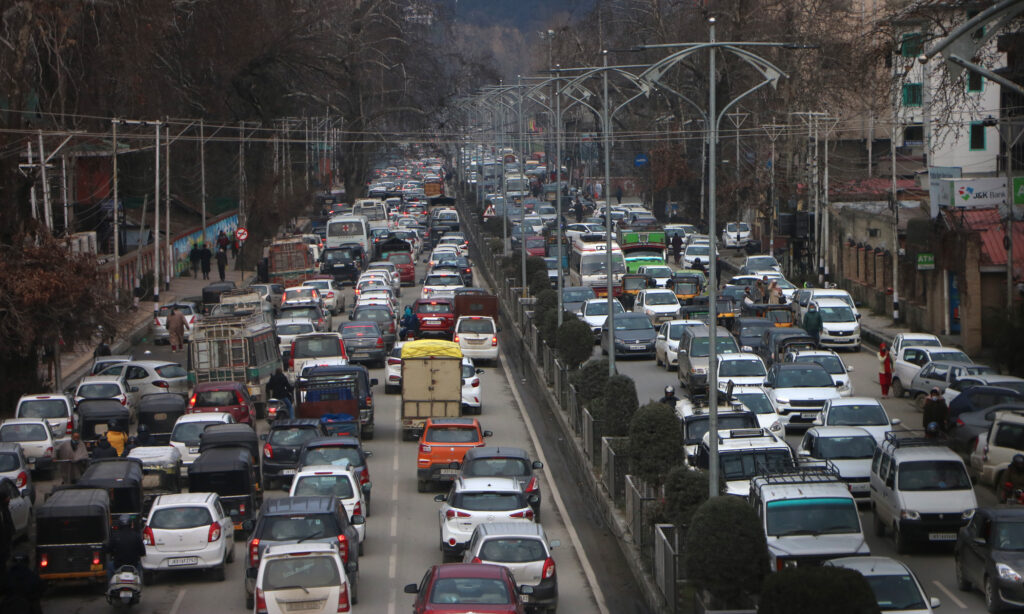Last week, traffic cops were spotted flagging down private vehicles near Srinagar’s Zero Bridge and fining the offenders for using high beam headlights.
Citing Section 177 of the Motor Vehicles Act, the city traffic chief told a local news agency that the department has launched a campaign against those who are found using high beam lights or have LED lights or strips on their vehicles.
The traffic department has, of late, taken a stern action against ‘serious’ traffic violators and sent their cases to traffic courts which have pronounced strict punishments, including imprisonment.
In one such case, a transport judge sentenced an offender to six-month imprisonment for altering and upgrading his Thar vehicle.
While legal action against offenders is a welcome move, it is also reasonable to wonder why the traffic authorities have been ignoring more pressing issues that have led to a serious traffic situation not just within the city limits but also in the suburbs.
There are a host of offences that the traffic police seems to be completely ignoring. To begin with, roadside merchants and footpath vendors have choked the roads on each side, making it extremely difficult for vehicles to pass. The traffic department puts the onus on the Srinagar Municipal Corporation (SMC) for allowing the encroachment of roads and, thus, severely burdening the traffic department. Tragically, the city’s persistent traffic congestions are made worse by barricades and bunkers erected by police and paramilitary for security reasons.
A regular motorist on the road, however, suffers the brunt of this neglect and pays the price in this blame game. It takes prize-winning expertise for a person to manoeuvre through such congested routes.
The traffic condition in Batamaloo, Qamarwari, Jahangir Chowk, Dalgate, Nowhatta and many other locations around the city is the greatest illustration of the type of bottlenecks caused by the traffic department’s willful ignorance and an apathetic Srinagar Municipal Corporation. This provides an opportunity for some officers who, by indulging in bribery, compound further the already complicated situation.
Despite traffic department’s digital penalty system, using cameras and other technology to punish violators, a sizable portion of drivers—including those of cars, bikes, and scooters—do not possess valid licenses.
Use of a helmet by both the motorcyclist and the pillion rider is hardly witnessed and, ironically, this too escapes the traffic department’s digital net. The only way such a flagrant infraction could go unchallenged is if the on-duty police officer does not take his job seriously for whatever reason.
Additionally, it appears that the entire traffic department is concentrated between the Civil Secretariat area and the Gupkar Road, where the policemen can be at their active best, as if the traffic on other routes is not at all within their purview.
There are so many spots across Srinagar where cars are seen parked illegally on regular basis. You condition a driver to commit an offence because most of the times they get away with any action. And more often than not, it is the once-in-a-while offender who gets caught because suddenly once in two months, the traffic department swings into action and seizes such vehicles until the next drive which may take another couple of months to initiate. From the next day, it’s business as usual. Why can’t the traffic department act on a daily basis and deprogram offenders by sending them a clear message that they can be taken to task every time they violate a rule? Also, once a vehicle has been seized and towed away, releasing it is a real headache.
Even while the installation of traffic lights paints a positive picture of Srinagar’s traffic system, the fact that the traffic lights are only followed at hardly a few locations is yet another indication of the traffic department’s ineptitude.
That said, people too need to look inwards for regularly violating the traffic signal. But the major part of the responsibility still lies with the traffic department for not effectively ensuring that traffic signals are respected. Contrary to other Indian cities, the traffic department in Srinagar does not use the media to educate the public about adhering to the traffic regulations.
We don’t see a vibrant media presence as far as our traffic department is concerned.
The process of obtaining a driving licence from the Regional Transport Officer’s (RTO) office is flawed from the get-go. A candidate is put through a quick driving test on a set day after getting a learner’s licence by responding to a few questions, rather than having their driving manners evaluated. What could be more ironic than having to drive a car in reverse for only five minutes to pass the test and be deemed fit to drive? For that matter, driving requires a skill set that characterises a driver’s personality, which is unfortunately missing here.
There is also a pressing need for the traffic authorities to build a rapport with people and continue to educate them, both through mass media and through personal interaction,


